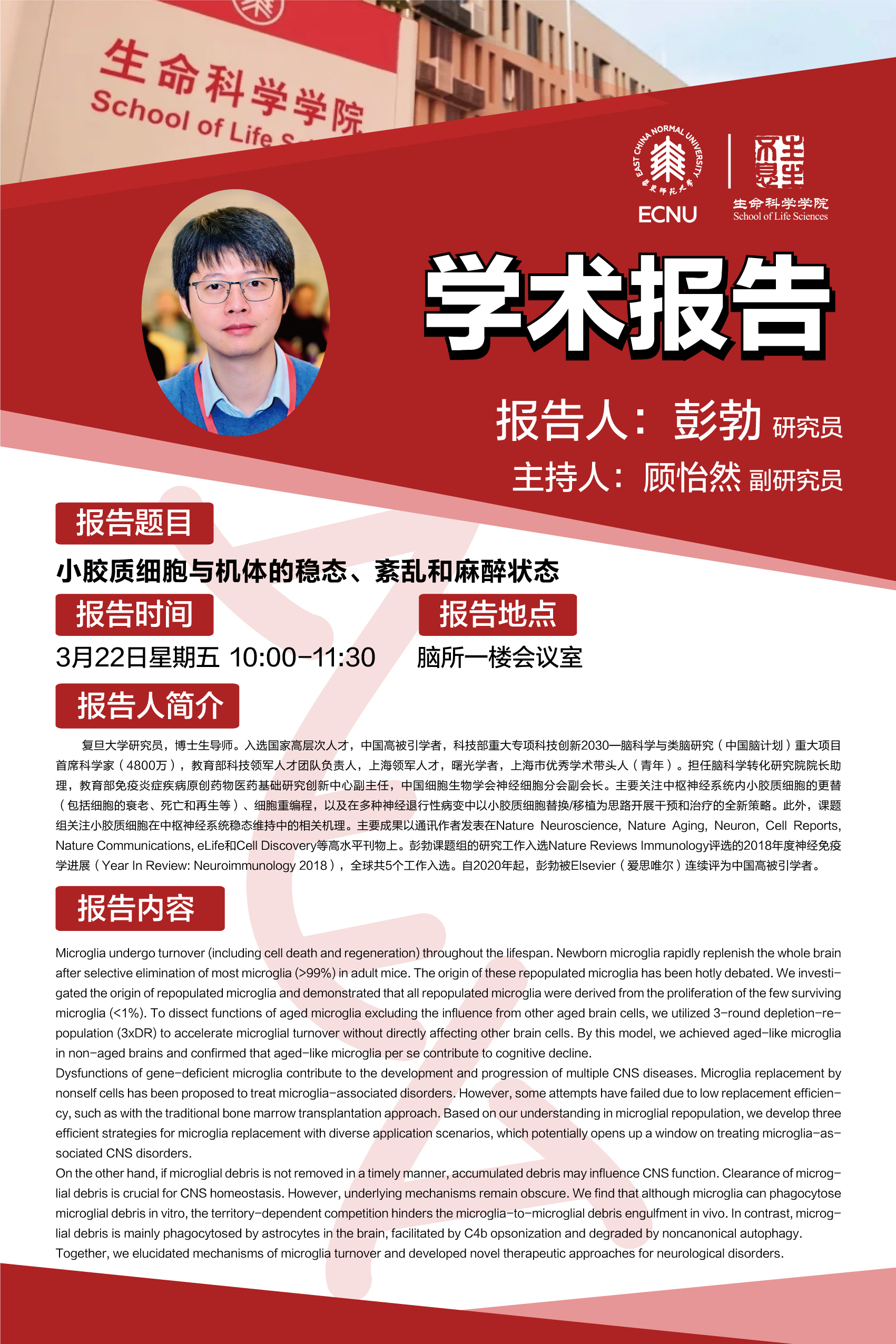



报告题目:小胶质细胞与机体的稳态、紊乱和麻醉状态
报 告 人: 彭 勃 研究员 复旦大学
主 持 人: 顾怡然 副研究员
报告时间:3月22日上午10:00-11:30
报告地点: 普陀校区脑所一楼会议室
报告人简介:
复旦大学研究员,博士生导师。入选国家高层次人才,中国高被引学者,科技部重大专项科技创新2030—脑科学与类脑研究(中国脑计划)重大项目首席科学家(4800万),教育部科技领军人才团队负责人,上海领军人才,曙光学者,上海市优秀学术带头人(青年)。担任脑科学转化研究院院长助理,教育部免疫炎症疾病原创药物医药基础研究创新中心副主任,中国细胞生物学会神经细胞分会副会长。主要关注中枢神经系统内小胶质细胞的更替(包括细胞的衰老、死亡和再生等)、细胞重编程,以及在多种神经退行性病变中以小胶质细胞替换/移植为思路开展干预和治疗的全新策略。此外,课题组关注小胶质细胞在中枢神经系统稳态维持中的相关机理。主要成果以通讯作者发表在Nature Neuroscience, Nature Aging, Neuron, Cell Reports, Nature Communications, eLife和Cell Discovery等高水平刊物上 。彭勃课题组的研究工作入选Nature Reviews Immunology评选的2018年度神经免疫学进展(Year In Review: Neuroimmunology 2018),全球共5个工作入选。自2020年起,彭勃被Elsevier(爱思唯尔)连续评为中国高被引学者。
报告简介:
Microglia undergo turnover (including cell death and regeneration) throughout the lifespan. Newborn microglia rapidly replenish the whole brain after selective elimination of most microglia (>99%) in adult mice. The origin of these repopulated microglia has been hotly debated. We investigated the origin of repopulated microglia and demonstrated that all repopulated microglia were derived from the proliferation of the few surviving microglia (<1%). To dissect functions of aged microglia excluding the influence from other aged brain cells, we utilized 3-round depletion-repopulation (3xDR) to accelerate microglial turnover without directly affecting other brain cells. By this model, we achieved aged-like microglia in non-aged brains and confirmed that aged-like microglia per se contribute to cognitive decline.
Dysfunctions of gene-deficient microglia contribute to the development and progression of multiple CNS diseases. Microglia replacement by nonself cells has been proposed to treat microglia-associated disorders. However, some attempts have failed due to low replacement efficiency, such as with the traditional bone marrow transplantation approach. Based on our understanding in microglial repopulation, we develop three efficient strategies for microglia replacement with diverse application scenarios, which potentially opens up a window on treating microglia-associated CNS disorders.
On the other hand, if microglial debris is not removed in a timely manner, accumulated debris may influence CNS function. Clearance of microglial debris is crucial for CNS homeostasis. However, underlying mechanisms remain obscure. We find that although microglia can phagocytose microglial debris in vitro, the territory-dependent competition hinders the microglia-to-microglial debris engulfment in vivo. In contrast, microglial debris is mainly phagocytosed by astrocytes in the brain, facilitated by C4b opsonization and degraded by noncanonical autophagy.
Together, we elucidated mechanisms of microglia turnover and developed novel therapeutic approaches for neurological disorders.
